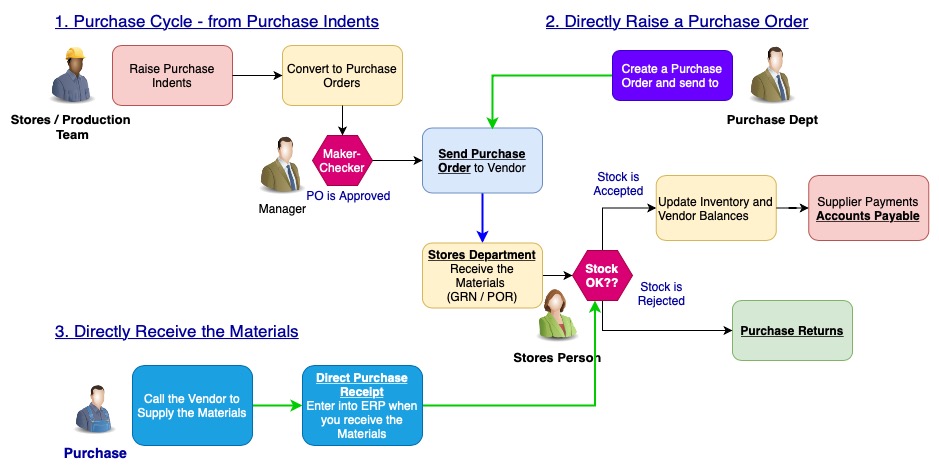Enhance Business Efficiency with Purchase Receipts and Goods Receipt Notes
Introduction
In the world of business, efficient operations and smooth transactions are key to success. One often-overlooked aspect that holds immense significance is the purchase receipts. This essential document, also known as a Goods Receipt Notes or Purchase Order Receipts, plays a pivotal role in streamlining procurement processes and ensuring accurate record-keeping.
What is a Purchase Receipts?
A Purchase Receipts, also referred to as a Goods Receipt Note (GRN) or Purchase Order Receipt, is a formal document generated after the successful receipt of goods from a supplier. It acts as proof of the transaction between a buyer and a supplier, indicating that the goods ordered have been delivered as per the terms and conditions agreed upon. This document serves as a crucial link between the procurement and financial departments within a business.
Vendor can send his delivery note or packing slips or Invoice to Customer and based on that we do receive the materials into Inventory. Physical items received are checked and verified. So receipt validation technique could be checking Physical stocks and checking at Quality Process too. These GRNs are used for Accounts Payable and track business Cash flows too.
In case, you use any Cloud-Based ERP Software, as the stocks are received, the financial transactions are also posted. Each GRNs Documents Serial Number Receipts are documented and controlled.
Multiple types of receipts and ways to receive the materials.
- Purchase Order and materials receipt by purchase order
- Direct receive the materials without any PO.
Importance of Purchase Receipts in Business
The importance of a purchase receipt in business cannot be overstated. It serves as a vital record for various purposes, including accounting, inventory management, and compliance. By documenting the details of each transaction, businesses can effectively track their expenses, manage inventory levels, and ensure transparency in their dealings.
Details Contained in a Purchase Order Receipts
A well-structured Purchase Order Receipt contains a wealth of information that facilitates accurate record-keeping and business analysis. Some of the key details included are:
- Date of receipt
- Supplier’s name and contact information
- Buyer’s name and contact information
- Purchase order number
- Itemized list of received goods
- Quantity, description, and unit price of each item
- Total cost of the transaction
- Any applicable taxes or discounts
What is the difference between Purchase Quotation and Goods Receipt Notes?
Before a purchase receipt is issued, a purchase quotation plays a significant role. A purchase quotation is an initial document provided by a supplier, detailing the terms and conditions of a potential transaction. It allows buyers to compare offerings and make informed decisions. On the other hand, Goods Receipt Notes (GRNs) verify the physical receipt of goods and their conformity to the original order.
Types of Purchase Order Receipts
There are primarily two types of purchase receipts:
- Direct Purchase Order Receipt: This occurs when goods are purchased directly from a supplier without the need for intermediaries.
- Purchase Receipt through Intermediaries: In this case, goods are acquired through intermediaries or agents.
Difference between Sales Quotation and Procurement Quotation
While both sales and procurement quotations involve providing potential buyers with details of products or services, their focus and purpose differ. A sales quotation aims to attract customers and secure sales, highlighting benefits and features. A procurement quotation, on the other hand, focuses on presenting competitive pricing and terms to potential buyers to facilitate their purchasing decisions.
Significance of Quotation in Procurement
Quotations in procurement enable buyers to compare offerings from different suppliers, negotiate favorable terms, and make well-informed decisions. They contribute to cost savings, quality assurance, and effective supplier relationship management.
Goods Receipt Notes (GRNs)
A Goods Receipt Note (GRN) is a formal acknowledgment of the physical receipt of goods from a supplier. It is prepared by the receiving department and contains details such as item descriptions, quantities received, and quality assessments. GRNs play a critical role in verifying the accuracy of delivered goods against the purchase order.
Explaining the 7-Step Procurement Process
The procurement process involves seven essential steps:
- Identifying Need: Recognizing the need for goods or services within the organization.
- Supplier Identification: Identifying potential suppliers and soliciting quotations.
- Supplier Evaluation: Evaluating suppliers based on criteria such as quality, price, and reliability.
- Quotation Analysis: Analyzing received quotations to select the best-suited supplier.
- Purchase Order Creation: Generating a purchase order with agreed terms and specifications.
- Goods Receipt: Physically receiving the goods and creating a Goods Receipt Note (GRN).
- Invoice Matching and Payment: Matching the GRN, purchase order, and supplier invoice before processing payment.
In ACTouch ERP, we bring in Inventory into ERP by many ways. Some are explained as below.
- Purchase Indents -> Purchase Order -> Purchase Order Receipts of materials
- Directly Raise a Purchase Order -> Receive the materials
- Direct Purchase Receipt and this will update the stocks.

Purchase receipts, along with its variations such as Goods Receipt Notes and Purchase Quotations, plays a pivotal role in enhancing business efficiency and transparency. By meticulously documenting transactions and adhering to the procurement process, businesses can optimize their operations, control costs, and build stronger relationships with suppliers.
Embracing these practices ultimately paves the way for sustainable growth and success in the competitive business landscape.
|

